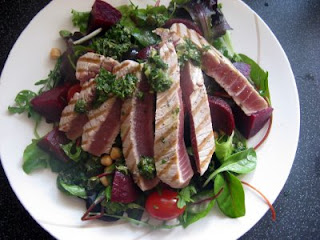One of our favorite memes at the Detritus is food metaphors. Oh, no words seem to explain the greatness of a piece of music quite like the comestibles it has nothing to do with.
Today's entry comes to us from the Richmond Times-Dispatch where Angela Lehman-Rios has the difficult task of explaining the difference between a "concerto" and a "concerto for orchestra".
Symphony impressive on a wide range of works
Saturday's Masterworks concert by the Richmond Symphony explored the relationship of parts to a musical whole.
I'm not at all certain what that means, but it sure does sound important.
What parts are we breaking down today. Are we just looking at rhythm? or perhaps harmony? Perhaps those are bit too broad...timbre maybe?
Oh, why guess when you can just tell me.
While the parts were sometimes more interesting, the sum was certainly a pleasure to behold.
So, the parts were more interesting, but you liked the whole thing too?
What were we comparing again?
The program started with "D'un Matin de Printemps" by Lili Boulanger.
Oh, no time for that "parts to the whole" discussion...looks like we've got actual music.
From its shimmering beginning to its full-bodied end, the short work demonstrates the grace and power of an orchestra playing all together.
Yes, the piece features a burst of bold raspberry, slutty kiwis and rambunctious African horned melons, along with hints of chicken, gravel and compost. After a short fugal explosion of toner, semisynthetic organic amorphous solids, and black currant, there is a long finish of nacho cheese with an intriguing ferrous hint.
Conductor Erin Freeman easily drew a rich, balanced sound from the musicians.
Excellent! So, it's as though Erin Freeman made a cohesive whole from the sum of the parts.
I like the unity. Go on.
Tchaikovsky's Concerto in D major for Violin and Orchestra, on the other hand, is a showpiece for a soloist.
Yes, I know what a concerto is, thank you very much.
[snip]
Okay, so far so good. What else was on the concert?
The evening concluded with the five-movement "Concerto for Orchestra," written in 2002 by Jennifer Higdon.
Wait, what? You said this is a concerto...but for what instrument? "Orchestra" is not an instrument, but instead is the sum of many instruments.
This work combines or isolates parts of the orchestra -- entire sections or players within a section -- in various ways, and also gives the full orchestra the sort of brilliant writing a concerto soloist gets.
So, it's a standard orchestra piece? I guess I don't follow. Perhaps you can break this down for me in easier to understand terms.
Think of a salad, if you will.
Okay. A salad.
A violin concerto is grilled tuna atop a bed of greens...,
 Whoa, whoa. Slow down...
Whoa, whoa. Slow down......violin. concerto. is. grilled. tuna...
...but Higdon's work is a Greek salad:
 ...Higdon's. is. Greek. salad. Got it.
...Higdon's. is. Greek. salad. Got it.Okay. But what does it all mean?
In any bite, the feta, the pepperoncinis or the crisp lettuce may stand out, but the flavors work together as a whole.
But the tuna doesn't work together with the greens?
I think I understand?
Nevertheless,...
What do you mean, "nevertheless". We were just on the edge of breakthrough!
Okay, we'll move on, but this better be good.
...the second and fourth movements are perhaps most attractive for new listeners,...
What kind of salad are they?
...since they single out sections of the orchestra (string and percussion, respectively), which makes it simpler to take in something unfamiliar.
Huh? So the reason new music has had such a difficult time finding mainstream audiences is the fault of the woodwinds and the brass sections?!?
Does Brian Ferneyhough know this?
The symphony's percussionists were clearly enjoying the chance to demonstrate a vast range of sounds, and delighted murmurs could be heard from the audience.
Don't they know you're not supposed to talk in between movements? That's like talking with your mouth full. It's just gross.
The third movement features short solos played by section leaders who are joined by the section and often paired with another section.
The section leaders are joined by the section and paired with another section?
Strangely, that couldn't make more sense.
Yes, pairing section leaders with a contrasting side section can be an effective way to build a menu...er, I mean work.
The violas, led by Molly Sharp, made delicious work of their tune,...
[insert food joke here]
...while Russell Wilson's piano and Lynette Wardle's harp were also highlights. Leisurely crescendos and decrescendos bind the elements together, as does a sliding motif played by the strings, although it becomes tiresome.
Yep, her music only has two moves: shake, and bake.
The full orchestra performed expertly in the first and fifth movements, and the piece ended with a flashy Hollywood-esque cadence that made the audience laugh.
Hehe. Film music is funny.
...
sigh.

1 comments:
But you love Shake 'n' Bake; you used to put it in your coffee!
Post a Comment